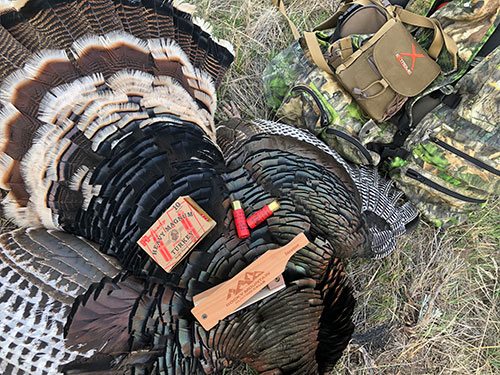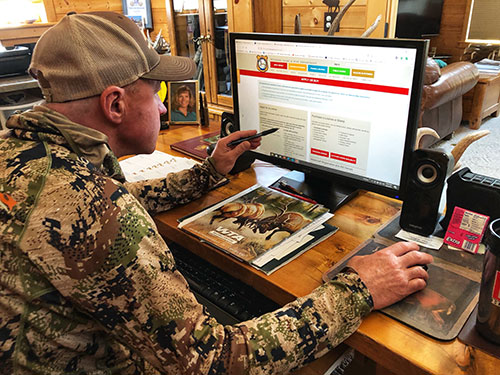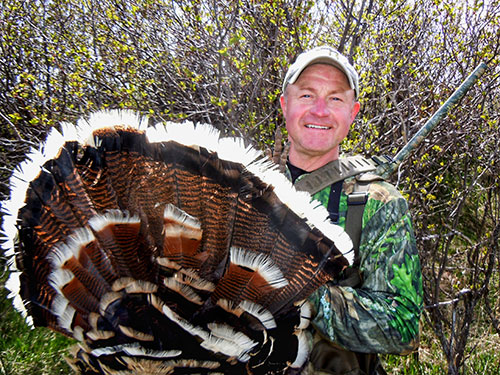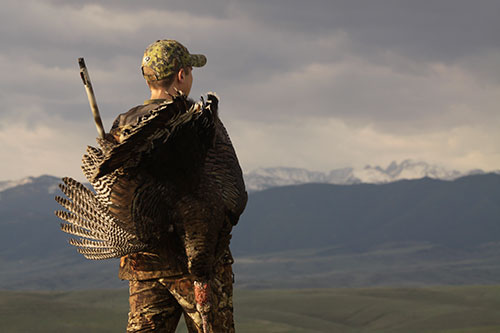Head west for an epic longbeard adventure.
By Mark Kayser
The reverberating volume of the gobble told the tale of a tom closing the distance in the ponderosa pines of Wyoming’s Black Hills. A small rise, less than 40 yards away, set the stage for the Merriam’s appearance. One last, soft series of yelps pushed the gobbler to peek over the ridge at the decoy between us. It was lights out and tagged out on another western Merriam’s tom.
America is home to five distinct subspecies that make up a Grand Slam turkey prize. This trophy turkey feat includes the Eastern, Osceola, Rio Grande, Gould’s and Merriam’s. Winning a popularity contest for many is the grand Merriam’s, found in the West and Southwest. Named after C. Hart Merriam, the first chief of the U.S. Biological Survey way back in 1900, Merriam’s turkeys have numerous admirable traits, including a striking appearance with their snow-white tipped tails. Appearances aside, more rewards await if Merriam’s fever affects you.
EASY LICENSING AND FOUND IN A STRIKING BACKDROP
Although you may be challenged to draw an elk tag in many western states, the same cannot be said about licenses for Merriam’s. Many states offer options for both over-the-counter tags and draw units. This means that if you choose a state like Colorado or New Mexico, you still have an opportunity to hunt even if you do not draw a premiere unit. States like South Dakota have an unlimited option for the Black Hills and draw permit units in the prairies to the west. Montana has an OTC tag and so does Wyoming, plus Wyoming has several units with the chance to draw a second tag. Nebraska really shines with the option to purchase two tags, but this year they did cap the limit at 10,000 nonresident licenses available, so purchase yours early.
As noted, acquiring a tag takes little in terms of research, but the big payout is the backdrop you get to hunt. Now don’t get me wrong, the Midwest, East and Southeast offer some striking views, but seeing snowcapped peaks in the distance and mountain ranges of pines elsewhere make you just want to pull up a John Denver song on your playlist as you travel toward your destination.

Merriam’s habitat varies from the high mountains to valley rivers. Expect turkeys to use habitat at any elevation. Photo credit: Mark Kayser
Merriam’s reside in at least 15 of the Western and Southwestern states, with forays into Great Plains settings from the Dakotas south to the panhandle of Oklahoma. They range from elevations starting near 2,000 to more than 9,000 feet above sea level. Survivors of harsh winter conditions, Merriam’s find refuge in cottonwood river bottoms and high into the ponderosa and lodgepole pine mountains. They migrate in many locations to escape the snow and then return to the high country for summer range. Landscapes provide eye candy, but be prepared for quick-changing weather in more northerly and high-elevation hunts.
SHOWOFFS BY NATURE, EASY TO FIND
Another attribute that garners attention is that Merriam’s do not mind a bit of attention while roaming their homeland. In most instances, they are easy to find. Why? The habitat that they inhabit provides ample space to see them from a distance. Plus, when the spring rowdiness rises, their gobbles travel a long way.
As important as calls are to turkey hunting, I typically rely on my binocular first to locate turkeys. My SIG SAUER 10-power binocular rests on my truck dash to verify if dark dots in the distance are turkeys or merely bird-looking brush. Even in timbered settings you will find Merriam’s roaming the edges of meadows, parks and sagebrush basins. In lower elevation settings, scan riparian zones, pastures and cultivated fields for flocks.
Open forests and openings provide the buffet for a species that eats almost anything, another reason you can spot birds. In the early spring, before the green-up, Merriam’s target grain fields, hayfields, pine mast, dried grass and anything they can root up. In wintry landscapes, they may depend on ranchers and farmers as they scratch for leftovers in feeding areas. Find one of these livestock settings in the early spring for a guaranteed flock meeting. In the mountains they scratch for food along south-facing slopes that are free of snow.
Unlike many Midwest or Eastern locations, roads don’t exist every mile to give you easy access and visibility. That means turkeys have breathing room and may spend more time out of cover and moving about, thus giving you the optic advantage from afar to find them. Here is a bonus tip, stash your spotting scope in the truck to confirm dots even farther than identifiable with a binocular. A spotting scope with 15- to 60-power zoom gives you ample focus to see turkeys on faraway slopes.
Besides the openness of the West, be aware of any water sources in a region. Generally, the West can be a dry place. Wildlife seeks out and patterns to water sources in extremely arid regions. Merriam’s turkeys are no exception. Some of the areas that I have hunted have an annual rainfall of less than 18 inches, so scout for reservoirs, potholes, creeks and rivers that provide hydration.
GOBBLING FOOLS THAT LOVE TO HEAR CALLS
Every turkey species has its own tendency to speak up during the spring breeding melee. Nevertheless, over years of traveling for turkey hunting, I sure enjoy returning home to hear Merriam’s gobblers after hunting other species that seem to shut down at the slightest hint of pressure.

Bring along a few extra calls to achieve the high pitch and to change out if you discover turkeys that prefer a particular sound over another. Changing your cadence and adding in turkey flock banter like cutting, clucks, putts and purrs all could make a flock trot into view with a tom in tow. Photo credit: Mark Kayser.
Merriam’s just like to hear themselves gobble. Often, a roosted longbeard will sound off more than 100 times before hitting the ground. And when they do finally land on terra firma, they continue the talk, even throughout the entire day.
No doubt you may run into a quiet tom from time to time, but it typically does not take much banter to fire one up. If I could point out one mistake that newcomers to Merriam’s country make, is not calling enough.
Merriam’s country is big so not only do you want to try and cover country to find a flock, but you also need to do it with calling that will carry farther in Big Sky Country like Montana. Years ago, a seasoned hunter shared with me that not only do you want to be loud in the West to make your sound travel farther, but he researched calls with a high-range pitch. He believed that the higher tone carries farther with realism. Use your lungs to push the sound out, but also get up high to send the sound over any terrain. A high vantage point also gives you a perch to glass from since you may not hear a responding turkey, but you could see one arriving from afar with your optics.
Lastly, bring along a few extra calls to achieve that high pitch and to change out if you discover turkeys that prefer one particular sound over another. Changing your cadence and adding in turkey flock banter like cutting, clucks, putts and purrs all could make a flock trot into view with a tom in tow. My call pocket in my vest includes a selection of diaphragm calls from Rocky Mountain Hunting Calls, plus their Turkey Strutter Box and their Atomic 13 aluminum pot call. This selection is lightweight to carry and provides ample personality changes when needed.
GULLIBLE PERSONALITIES THAT LOVE A DECOY DATE
If a Merriam’s personality of enjoying openness and screaming back to your calls has you pining for a trip West, do not forget to pack your favorite decoys. Even in timber, turkeys look for the maker of calls. And in any open setting, expect those same turkeys to eyeball everywhere for the creator of the wildland uproar.
Whether you use a single hen, a jake or tom, or a pair of hens with a tom is up to you, and what is happening at that point in the season. In the early season a lone tom or jake may be the answer as a tom already has ample hens in the large flocks just splitting up from winter. In the midseason you can again go with a lone tom or jake, but that same male turkey overseeing a hen could incite a dominance response for breeding rights. Finally, late in the season a lone hen may be the proper route. Toms are getting tired and their fight eagerness waning. They may just want to hook up with a lonely hen and call it a great spring.
What you will want to research are lightweight decoy options. Carrying full-size shell decoys not only weighs more, but requires packing large loads in big country. A more efficient option is to consider folding decoys, like those from Montana Decoy. These innovative decoys compress into a smaller space, but spring into a full-size turkey with half the weight or less of traditional models. The Miss Purrfect and Jake Purrfect XD decoys give you plenty of options while in Merriam’s backcountry without adding in the weight of a kitchen sink to your hunting vest.
Before your hunt, I recommend that when you pattern your shotgun, take a couple shots from a prone position. You may find yourself far away from any trees, depending on the situation. Staking decoys out in open ground and setting up prone in the backdrop has been a go-to of mine for years. Turkeys simply do not look for danger in the short grass. My daughter and I once set up along a ranch trail and doubled on a pair of overanxious gobblers with a date for the grill.
ALWAYS A PLACE TO HUNT
Ease in licensing aside, another attractive feature of hunting Merriam’s is the fact that they live in a region sporting high percentages of public land. Wyoming is nearly 56% publicly owned, New Mexico 47%, Idaho 70% and Montana nearly 38% publicly owned. Great Plains states represent fewer acres, but South Dakota’s Black Hills National Forest boasts more than 1 million acres of Merriam’s habitat.

One great aspect of turkey hunting in the West is that licenses are typically easy to acquire and oftentimes, over-the-counter. Photo credit: Mark Kayser.
National forests and Bureau of Land Management acres make up the bulk of the public offerings, but do not ignore state lands, county lands, wildlife refuges, military bases and other smaller, overlooked government holdings with turkey potential. Most national forests in the West average approximately 1 million acres. Take Colorado, for instance. It includes 12 national forests amassing nearly 14 million acres. My home state of Wyoming has 10 national forests totaling nearly 9 million acres. Montana has 11 national forests with more than 17 million acres. Granted, turkeys do not live in all of these locales, but when you add in BLM ground, state lands and others, you can find a place to plop down and call.

The author celebrates success over the beauty of a grand Merriam’s tail fan. Photo credit: Mark Kayser.
Despite big numbers, you also must remember that not all acres are easily accessible — or accessible at all. Some of these acres require a day or more to trek into backcountry settings. Other acres are landlocked. Open your hunting app and explore the acres of public-land opportunity in the West. Hunting apps, like HuntStand, make finding public lands easy in the oftentimes checkerboard setting of property ownership, and help prevent you from having a meeting with law enforcement.
You may have access to a private property brimming with Easterns or Rios, or another species, but if you hanker for something new, including the view, consider a Western Merriam’s hunt. The rewards from a trip out West are many, and can give you the turkey hunt of a lifetime.

